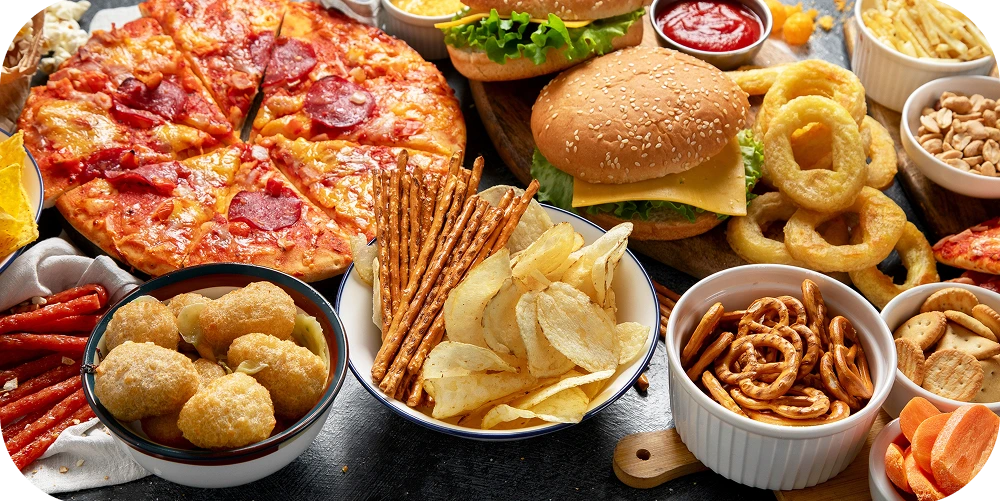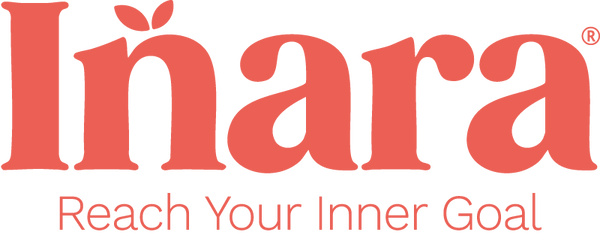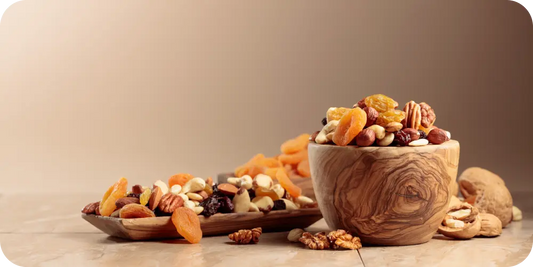How To Control Food Cravings? The Ultimate Guide
Mene Mestanas
Food cravings can derail your healthy eating plans. This guide offers straightforward tips on how to control food cravings. You’ll learn about common triggers, hydration strategies, protein’s role, and more. These insights will help you curb cravings and achieve your health goals.
Key Takeaways
- Understanding triggers, such as emotional states and environmental cues, is essential for managing food cravings.
- Staying hydrated and increasing protein intake can significantly reduce appetite and help control cravings.
- Practicing mindful eating and meal planning can create healthier habits and diminish the frequency of food cravings.
Understand the Triggers of Food Cravings
The first step in managing food cravings is to understand what triggers them. Emotional states, such as anxiety or sadness, can significantly heighten food cravings. Stressful situations often lead individuals to crave high-calorie comfort foods, seeking solace in the temporary pleasure they provide. For instance, after a hard day at work, you might find yourself gravitating towards a tub of ice cream or a bag of crisps, especially when you experience food cravings, particularly for fatty foods.
Environmental cues also play a significant role in the food environment. The sight or smell of certain foods, often amplified by adverts, can trigger cravings even when you’re not hungry. Food stimuli in social settings can be another minefield; peer influence can encourage you to indulge in food you might otherwise avoid. Think about those office parties or family gatherings where food is abundant and resisting temptation becomes a Herculean task.
Hormonal changes are another crucial factor. Fluctuations in hormones, estrogen and progesterone, during a woman's menstrual cycle, can increase the intensity of food carvings. Recognising these triggers allows you to develop strategies to manage them effectively, making it easier to maintain healthier eating habits and reduce the frequency of cravings.
Stay Hydrated
Hydration is a key player in the battle against food cravings. Often, we confuse thirst with hunger, leading to unnecessary snacking. Drinking adequate amounts of water can help manage your appetite more effectively. When you feel a craving coming on, try drinking a tall glass of water and wait 20 minutes. You might find that the craving diminishes or disappears entirely.
Drinking water before meals is also a powerful strategy. It can enhance weight loss by reducing your appetite, making you feel fuller faster. Studies have shown that drinking 500ml of water before meals can significantly aid in weight loss. It’s a simple yet effective way to control food intake without having to rely on willpower alone.
Moreover, maintaining proper hydration levels can help reduce the intensity and frequency of cravings. Incorporating this habit into your daily routine helps you manage your diet and make healthier food choices. So, next time you feel the urge to snack, reach for a glass of water first – it might just be the solution you need.
Include Protein in Your Diet
Protein is a powerful ally in the fight against food cravings. Increasing your protein intake can significantly reduce overall appetite and hunger pangs. When you consume more protein, you feel fuller for longer periods, which can help regulate your food intake. This means fewer urges to snack between meals and more controlled eating behaviors.
One of the key benefits of protein is its impact on hunger hormones. Consuming protein-rich foods has been shown to lower levels of ghrelin, the hormone responsible for signaling hunger. Additionally, protein increases levels of appetite-suppressing hormones like GLP-1, further reducing the likelihood of experiencing cravings. It’s about feeling less hungry, not just eating less.
Including protein in your meals and snacks can also help curb sugar cravings. Studies have found that a higher protein intake can reduce cravings for sugary foods by up to 60% (1). So whether it’s a protein-rich breakfast to start your day or a handful of nuts as a mid-afternoon snack, incorporating more protein into your diet can be a game-changer in managing your cravings.
Tip: The Inara GLP-1 powder is also an effective dietary supplement for those struggling with craving control. It is made with science-backed ingredients like InnoSlim®, Green Tea Extract, and Choline, and has several other benefits that support your health naturally.
Practice Mindful Eating
Mindful eating is a practice that can transform your relationship with food. By practicing mindfulness related to foods and eating, you enhance your awareness of hunger and cravings. This heightened awareness helps you distinguish between actual hunger and emotional cravings, leading to better food choices.
To practise mindful eating, slow down, chew thoroughly, and avoid distractions during meals. Taking deep breaths before eating can help center your attention and prepare your mind for a mindful eating experience. Focus on the colours, textures, and aromas of your food. This not only enhances the eating experience but also promotes a slower pace, allowing you to recognise fullness signals more accurately.
Mindfulness practices can also help address emotional triggers that lead to impulsive eating. By being more attuned to your body’s signals and your emotional state, you can make more deliberate and healthier food choices. Practicing mindful eating can ultimately reduce cravings and prevent overeating, contributing to a more balanced and healthy diet.
Plan Your Meals and Snacks
Planning your meals and snacks is an essential strategy for managing food cravings. When you eliminate spontaneity and uncertainty, you reduce the likelihood of reaching for unhealthy snacks. Meal prepping ensures that you have healthy options readily available, minimising the chance of succumbing to junk food.
Creating a detailed shopping list is another effective method. It prevents impulse buys that may lead to cravings for unhealthy foods. By sticking to your list, you can make more mindful food choices and avoid the pitfalls of spontaneous snacking. Additionally, using portion control in meal prepping helps manage cravings by providing balanced meals that satisfy hunger.
Setting specific times for meals and snacks can help stabilise your hunger levels and reduce cravings. Healthy snacks like fruits, nuts, or vegetables are ideal choices to keep between meals, preventing extreme hunger and promoting better food choices. Planning ahead helps maintain a healthier diet and reduces the frequency of food cravings.
Manage Stress Effectively
Managing stress is crucial for controlling food cravings. High-stress levels can increase cravings and calorie intake, particularly in women. Addressing stress alleviates the urge to reach for comfort foods.
Techniques such as deep breathing, meditation, and physical activities can effectively reduce stress. Deep breathing exercises, for instance, can quickly lower stress and help control food cravings. Engaging in activities like yoga, walking, or even quick exercises can serve as powerful distractions from cravings and reduce their intensity.
Engaging in hobbies, listening to music, or taking up new activities can also help manage stress and shift your focus away from food. These strategies not only reduce stress but also provide a healthier outlet for your emotions, making it easier to maintain a balanced diet and control food cravings.
Get Enough Sleep
Sleep is a vital component of managing food cravings. Sleep deprivation significantly impacts hormone fluctuations, leading to increased cravings for carbohydrates and sugar. When you are sleep-deprived, you tend to have stronger cravings, making it harder to resist unhealthy foods.
Adequate sleep is crucial for controlling food cravings and preventing weight gain. By ensuring you get enough rest, you can regulate your hunger hormones more effectively and reduce the likelihood of experiencing intense cravings.
Prioritising sleep as part of your healthy eating routine can play a significant role in maintaining a balanced diet and overall well-being.
Distract Yourself from Cravings
Distracting yourself from food cravings can be an effective way to manage them. Activities such as reading a book, calling a friend, walking the dog, or even cleaning can shift your focus away from the craving. Engaging in these activities for at least 20 minutes can help break the hold of a craving.
Other effective distractions include taking a shower, chewing gum, or gardening. These activities not only divert your attention but also provide a healthy way to cope with the urge to snack. By incorporating distraction techniques into your routine, you can better manage food cravings and maintain healthier eating habits.
The key is to find activities that you enjoy and that can occupy your mind. Whether it’s a hobby, a physical activity, or simply a relaxing bath, these distractions can reduce the intensity of cravings and help you stay on track with your diet.
Avoid Extreme Hunger
Avoiding extreme hunger is essential for preventing food cravings. Regular meals help maintain stable energy levels and prevent feelings of intense hunger. Eating proper meals at designated times can help you manage your appetite more effectively and reduce cravings.
Including healthy snacks in your diet can also help curb hunger between meals. Nuts are a nutritious option that can keep you satisfied and prevent unhealthy snacking. Choosing snacks with fiber, such as fruits and vegetables, can promote satiety and maintain steady blood sugar levels.
By eating small amounts of food throughout the day, you can stabilise your blood sugar and prevent extreme hunger, which often leads to overeating and poor food choices. Maintaining a regular eating schedule and incorporating healthy snacks can help you manage your cravings more effectively.
Be Aware of Emotional Eating
Emotional eating is a common trigger for food cravings and can sometimes lead to binge eating. Reflecting on your hunger levels before eating can help you differentiate between physical hunger and emotional cravings. Mindfulness of your emotions helps you recognise when you’re eating for comfort rather than nourishment.
Keeping a journal can be a helpful tool in this process. It allows you to track your emotions and eating patterns, providing insights into your triggers for emotional eating. Talking to friends or family can also provide emotional support and reduce the urge to eat for comfort.
Engaging in hobbies and practicing gratitude for your food can create a positive mindset and foster healthier coping mechanisms. By being aware of emotional eating and implementing these strategies, you can reduce cravings and maintain a healthier relationship with food.
Summary
In summary, understanding and managing food cravings involves a combination of strategies. By identifying triggers, staying hydrated, including protein in your diet, practicing mindful eating, and planning your meals, you can significantly reduce cravings. Managing stress, getting enough sleep, distracting yourself, avoiding extreme hunger, and being aware of emotional eating are also crucial steps in maintaining control over your food intake.
Implementing these tips can lead to healthier eating habits and overall well-being. Take the first step today and start incorporating these strategies into your daily routine. You’ll find that with time and practice, controlling food cravings becomes second nature, paving the way for a healthier, happier you.
Frequently Asked Questions
How can I distinguish between hunger and cravings?
To distinguish between hunger and cravings, reflect on your body's hunger cues and assess whether your desire to eat is linked to emotional triggers. Practicing mindful eating can aid in recognising these differences effectively.
What are some healthy snacks to keep on hand?
Healthy snacks such as nuts, fruits, and vegetables are ideal to keep on hand, as they support energy levels and reduce the temptation for unhealthy options. Incorporating these into your diet can contribute to better overall health.
How does hydration affect food cravings?
Hydration plays a crucial role in managing food cravings, as thirst is frequently confused with hunger. Adequate water intake can help mitigate appetite and lessen the intensity of cravings.
What role does protein play in managing cravings?
Protein plays a crucial role in managing cravings by reducing overall appetite and hunger pangs, as it influences hunger hormones and promotes feelings of fullness. This makes it easier to control cravings effectively.
How can I manage stress to reduce food cravings?
To manage stress and reduce food cravings, employ techniques such as deep breathing, meditation, physical activities, and engaging in hobbies. These methods can effectively alleviate stress and curb the desire to snack.
SOURCES:
-
PubMed Central
https://pmc.ncbi.nlm.nih.gov/articles/PMC4564867/



